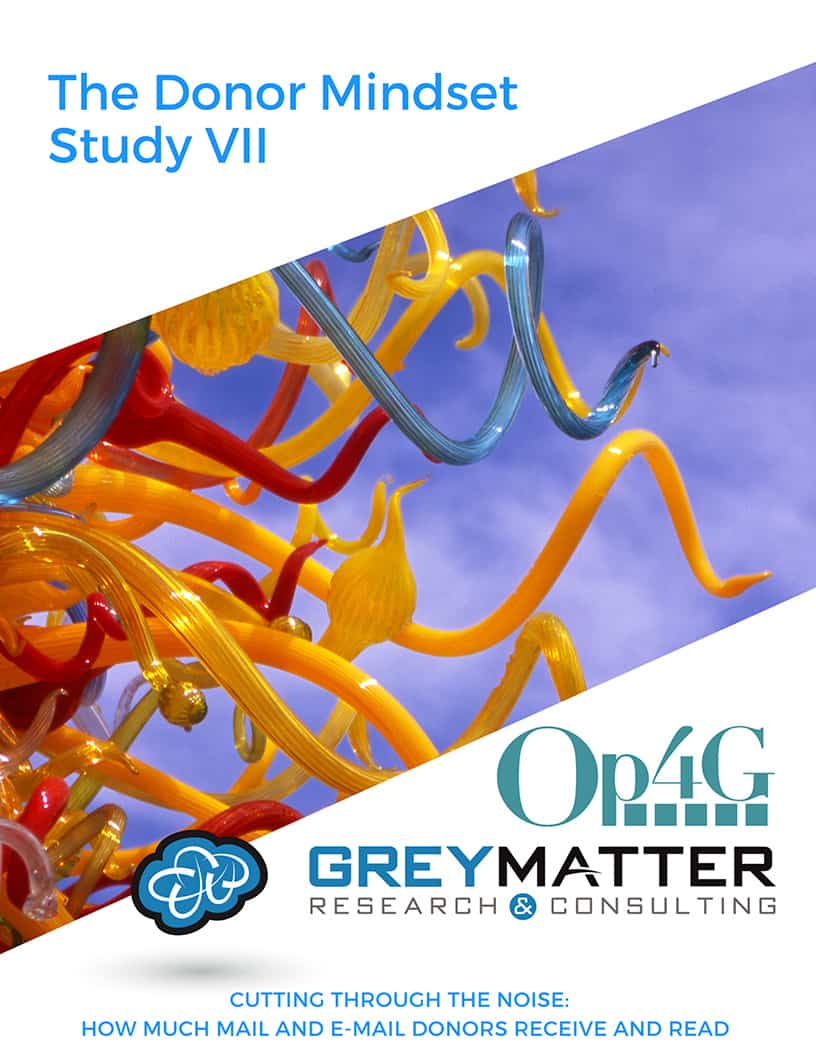
Cutting through the noise is critical in your organization’s communication with donors and potential donors. And as our research shows, there is a lot of noise.
The average American charitable donor reports receiving about eight mailings and ten e-mails from non-profit organizations in a typical week. A majority of these communications come from organizations they don’t financially support.
Grey Matter Research and Opinions4Good (Op4G) partnered on The Donor Mindset Study, a series of research reports about American charitable donors.
The latest in the series is The Donor Mindset Study VII: Cutting through the Noise. The report explores how much mail and e-mail donors report receiving from charities, as well as what proportion they actually read (all or in part).
There’s a lot of noise
The weekly averages, as reported by donors, look like this:
- 3.6 pieces of mail from organizations they financially support
- 4.2 pieces of mail from organizations they do not financially support
- 4.2 e-mails from organizations they financially support
- 5.7 e-mails from organizations they do not financially support
So that’s a total of 17.7 messages from charities each week. This means 920 per year, or 2.5 every day just between mail and e-mail. And this doesn’t include social media, text, advertising, or other forms of communication.
On average, donors estimate 54% of the mail and 58% of the e-mails they receive from charities come from organizations they don’t support (commonly referred to as “prospecting”).
Some people are “special”
Who gets the most communication from charities?
- People who identify with a religious group report receiving 24% more than atheists, agnostics, and those who have no religious identification
- Men report receiving 26% more than women
- Higher-income households ($70,000 or more) report receiving 30% more than lower-income households
- Larger donors ($500 or more given in the past 12 months) report receiving 37% more than others
- Political liberals report receiving 38% more than conservatives
- Donors under age 50 report receiving a whopping 77% more than older donors
In many ways, that list looks a lot like the ideal target for non-profits, doesn’t it? Wealthier, give more, and younger (as many organizations try to cultivate younger donors to help offset an aging donor base).
How Much goes to the round file?
The study also asked donors to estimate how many mail and e-mail messages from charities they actually read each week – not necessarily the whole thing, but at least part. It should be heartening to charitable organizations to learn that donors read quite a bit of the communication they get. On average, about 78% of what they receive from charities they financially support gets at least a little attention, along with about 58% of prospecting communications. So, apparently, at least some organizations are successfully cutting through the noise.
Few donors discard everything they get without reading it – only 7% do this with all the mail they receive from the organizations they support, and 25% do this with all the prospecting mail they get. The numbers for e-mail are strikingly similar. (Of course, they don’t take into consideration the e-mails donors never see because they’re caught in spam filters or sent to e-mail addresses donors rarely or never check).
Donor perceptions are critical
Ron Sellers, president of Grey Matter Research, notes that these estimates may not be exact counts of how many messages donors receive and/or read, but donor perceptions are still critical.
“In scores of studies we’ve done with individual organizations, donors often like to complain about the ‘overwhelming’ amount of fundraising mail and e-mail they get. It’s almost like a badge of honor to complain about the ‘waste’ and about how much the poor donor has to wade through,” Sellers commented. “But when we ask them to give thoughtful, numeric estimates of what they’re actually getting, a very different story emerges. They do receive quite a bit, but their physical and digital inboxes are not exactly overflowing. And most importantly, they’re not just tossing it all without reading it, so there’s relatively little actual waste to all these mailings and e-mails.”
Good news and bad news
Sellers noted that the study’s findings represent both good and bad news for charities. “It’s good news because on average, there’s about a three-in-four chance your donors are reading what you send them. There’s around a six-in-ten chance your prospects don’t just toss your stuff without a glance. So your message usually has an opportunity to be seen, even if very briefly” he noted. “It’s bad news because, of course, they’re also seeing what everyone else sends, which means there’s a lot of noise for you to cut through – hence the title of the report. So the question is: what’s going to make your communication something donors will read more of and maybe respond to, when they’re averaging 17 others that same week?” he asks.
The full study examines these donor perceptions more in-depth, with considerable detail. Please e-mail ron@greymatterresearch.com for a free copy of Cutting through the Noise.
How Can We Help You?
Grey Matter Research is a consumer insights company with extensive experience in research related to non-profit organizations. We have dozens of donor-supported organizations as clients. Grey Matter works directly with donor-supported organizations and in partnership with the fundraising, branding, and marketing services agencies that support them.
How can we help you?
